Physical Address
304 North Cardinal St.
Dorchester Center, MA 02124
Comprehensive preoperative, intraoperative, and postoperative care of the adult with congenital heart disease (ACHD) requires a solid understanding of the most common congenital heart defects and the reparative and palliative procedures used to treat them.
The current American Heart Association/American College of Cardiology published guidelines for management of adults with congenital heart disease are based on anatomy, physiologic status, and functional class.
Anesthesiologists caring for the ACHD must have a solid understanding of the concepts of physiologic shunting and effective blood flow, pulmonary hypertension, Eisenmenger syndrome, and Fontan palliation of single-ventricle lesions.
A thorough understanding of the interventions that can be used to manipulate the relationship between systemic and pulmonary vascular resistance is essential to the care of ACHD patients.
Adults with congenital heart disease have significant comorbidities related to end-organ dysfunction. These comorbidities are related to both aging and to the hemodynamic abnormalities associated with the patients’ underlying cardiac lesions and the reparative and palliative procedure they have undergone.
Patients with ACHD may require cardiac or noncardiac surgery. If possible, patients with moderate-to-complex ACHD who require noncardiac surgery should have it performed at an adult congenital heart center with consultation of an anesthesiologist experienced with ACHD.
The population of adults with congenital heart disease (ACHD) is growing due to advances in the diagnosis and treatment of congenital heart disease (CHD) in children and improvements in the management of these patients throughout childhood and into adulthood. It is commonly stated that there are more adults than children with CHD alive in the United States. In truth, defining the ACHD population is more complicated than it would appear. The range and heterogeneity of ACHD diagnoses, the difficulty of accurately identifying ACHD patients using datasets which were set up for other purposes, and the high rate of attrition from cardiology clinic visits all complicate efforts to define the population. The population of adult patients with a given congenital abnormality or specific repair may be relatively small because of the heterogeneity of the population, both in underlying anatomy and physiology as well as surgical repair or palliation. Nonetheless, using prevalence data from Canada it was estimated that about 2.4 million people (1.4 million adults, 1 million children) were living with CHD in the United States in the year 2010. Nearly 300,000 people (160,000 adults) were estimated to have severely complex CHD. Recent modeling predicts that the prevalence of CHD in adults (ages 20–64 years) will increase from 1.47/1000 to 2.31/1000 in 2050.
The prevalence of CHD in the adult population and the distribution of lesion severity are consistent worldwide. Data from the CONgenital CORvitia (CONCOR) database, a national registry and DNA bank of adult patients (>18 years) with CHD in the Netherlands provides granular data on the ACHD population. The mean age of patients in the databank was 37 years (49% male). The median survival was 53.4 years for patients with severely complex lesions, 75.4 years for moderately complex lesions, and 84 years for simple lesions. Survival of most patients with simple lesions did not differ from the general population, while survival of patients with severe and moderate lesions was substantially lower. Eighty percent of patients with severely complex lesions survive to age 40. In a sample of 3068 ACHD patients from Australia, 47% had simple lesions, 34% had moderately severe lesions, and 18% had severely complex lesions. The leading single cause of death was heart failure (HF; 17%) followed by malignancy (13%). Noncardiac causes such as malignancy were the primary cause of death in patients with simple lesions. Perioperative mortality only accounted for 5% of deaths. In a sample of 629 patients from Belgium, 26% had simple CHD, 58% had moderately complex CHD, and 16% had severely complex CHD.
Perhaps the best way to understand the breath and complexity of ACHD anatomy, physiology, and functional status is with the ACHD Anatomy and Physiological Classification system. This classification system was comprehensively articulated in the 2018 AHA/ACC Guideline for the Management of Adults with Congenital Heart Disease: A Report of the American College of Cardiology/American Heart Association Task Force on Clinical Practice Guidelines. It builds on the anatomic classification of ACHD first described in 2001 and used extensively since that time by adding physiologic and functional status staging, as summarized in Table 16.1 . Anatomy is classified using the International Pediatric and Congenital Cardiac Code (IPCCC) nomenclature and then classified as simple, moderate complexity, or great complexity (or complex). Physiologic and functional status staging is based on assessment of a comprehensive array of physiologic variables and comorbidities and by assignment of the patient to a New York Heart Association (NYHA) symptom class (I–IV). The variables used in this physiologic and functional assessment are summarized in Table 16.2 . A patient should be classified based on their highest-severity group. Classification should always reflect current clinical status and classification may change over time in either direction because of disease progression or in response to medical, surgical, or catheter-based interventions. A comprehensive analysis of this classification and the associated 2018 guidelines for anesthesiologists has been published.
| CHD Anatomy |
|
|
|
|
|
|
|
|
|
|
| Physiologic Stage |
|
|
|
|
|
|
|
|
| Variable | Description | |
|---|---|---|
| Aortopathy | Aortic enlargement is common in some types of CHD and after some repairs. Aortic enlargement may be progressive over a lifetime. There is no universally accepted threshold for repair, nor is the role of indexing to body size clearly defined in adults, as is done in pediatric populations. For purpose of categorization and timing of follow-up imaging | |
| Mild aortic enlargement is defined as maximum diameter 3.5–3.9 cm | ||
| Moderate aortic enlargement is defined as maximum diameter 4.0–4.9 cm Severe aortic enlargement is defined as a maximum diameter ≥ 5.0 cm |
||
| Arrhythmia | Arrhythmias are very common in patients with ACHD and may be both the cause and consequence of deteriorating hemodynamics, valvular dysfunction, or ventricular dysfunction. Arrhythmias are associated with symptoms, outcomes, and prognosis, and thus are categorized based on presence and response to treatment | |
| No arrhythmia: no documented clinically relevant atrial or ventricular tachyarrhythmia | ||
| Arrhythmia not requiring treatment: bradyarrhythmia, atrial or ventricular tachyarrhythmia not requiring antiarrhythmic therapy, cardioversion, or ablation | ||
| Arrhythmia controlled with therapy | ||
| Bradyarrhythmia requiring pacemaker implantation | ||
| Atrial or ventricular tachyarrhythmia requiring antiarrhythmic therapy, cardioversion, or ablation | ||
| AF and controlled ventricular response | ||
| Patients with an ICD | ||
| Refractory arrhythmias: | ||
| Atrial or ventricular tachyarrhythmias currently unresponsive to a refractory or antiarrhythmic therapy or ablation | ||
| Concomitant VHD | Severity defined according to the 2014 VHD guideline | |
| Mild VHD | ||
| Moderate VHD | ||
| Severe VHD | ||
| End-organ dysfunction | Clinical and/or laboratory evidence of end-organ dysfunction including | |
| Renal (kidney) | ||
| Hepatic (liver) | ||
| Pulmonary (lung) | ||
| Exercise capacity | Patients with ACHD are often asymptomatic notwithstanding exercise limitations demonstrated as diminished exercise capacity when evaluated objectively. Thus assessment of both subjective and objective exercise capacity is important (see NYHA classification system below). Exercise capacity is associated with prognosis | |
| Abnormal objective cardiac limitation to exercise is defined as exercise maximum ventilatory equivalent of oxygen below the range expected for the specific CHD anatomic diagnosis | ||
| Expected norms for CPET values should take into account age, sex, and underlying congenital diagnosis. Published studies with institution-specific norms can be used as guides, bearing in mind variability among institutional norms and ranges | ||
| Hypoxemia/hypoxia/cyanosis | ||
| Hypoxemia is defined as oxygen saturation measured by pulse oximetry at rest ≤ 90% | ||
| Severe hypoxemia is defined as oxygen saturation at rest ≤ 85% In patient with oral or high hemoglobin concentrations, severe hypoxemia will be associated with visible cyanosis (which required ≥ 5 g/L desaturated hemoglobin to be appreciated). |
||
| The terms cyanosis and hypoxemia (or hypoxia) are sometimes used interchangeably. Such interchangeability would not apply; however, in the presence of anemia, severe hypoxemia can be present without visible cyanosis | ||
| Pulmonary hypertension (PH) | PH is a broad term that encompasses pulmonary arterial hypertension (PAH), which is PH with increased pulmonary vascular resistance. This document defines PH and PAH as they are used in the field of PH | |
| PH is defined as: | ||
| Mean PA pressure by right heart catheterization ≥ 25 mm Hg | ||
| PAH is defined as: | ||
| Mean PA pressure by right heart catheterization ≥ 25 mm Hg and a pulmonary capillary wedge pressure ≤ 15 mm Hg and pulmonary vascular resistance ≥ 3 Wood units | ||
| Shunt (hemodynamically significant shunt) | An intracardiac count is hemodynamically significant if: | |
| There is evidence of chamber enlargement distal to the shunt | ||
| And/or evidence of sustained Qp:Qs ≥ 1.5:1 | ||
| Venous and arterial stenosis | Aortic coarctation after CoA repair | |
| Supravalvular aortic obstruction | ||
| Venous baffle obstruction | ||
| Supravalvular pulmonary stenosis | ||
| Branch PA stenosis | ||
| Stenosis of cavopulmonary connection | ||
| Pulmonary vein stenosis | ||
| NYHA Functional Classification System | Class | Functional Capacity |
| I | Patients with cardiac disease but resulting in no limitation of physical activity. Ordinary physical active does not cause undue fatigue, palpitation, dyspnea, or anginal pain | |
| II | Patients with cardiac disease resulting in slight limitation of physical activity. They are comfortable at rest. Ordinary physical activity results in fatigue, palpitation, dyspnea, or anginal pain | |
| III | Patients with cardiac disease resulting in marked limitation of physical activity. They are comfortable at rest. Less than ordinary physical activity results in fatigue, palpitation, dyspnea, or anginal pain | |
| IV | Patients with cardiac disease resulting in inability to carry on any physical activity without discomfort. They are comfortable at rest. Symptoms of heart failure or the anginal syndrome may be present even at rest. Discomfort increases with any physical activity | |
It is important to note that the ACHD Anatomy and Physiological (AP) Classification system has been validated as a risk stratification tool for prediction of short- and long-term morbidity and mortality and for prediction of progression to HF, , but has not been validated as a tool for prediction of perioperative risk for either cardiac or noncardiac surgery in adults. The American College of Surgeons National Surgical Quality Improvement Program (ACS NSQIP) classification of CHD lesions summarized in Table 16.3 is the basis of a validated tool for prediction of mortality following noncardiac surgical procedures in children with CHD. , A scoring system for risk stratification of ACHD patients undergoing noncardiac surgery has been proposed and is shown in Table 16.4 . It is also useful in categorizing lesions, but it is important to point out that this scoring system has never been validated.
| Classification | Definition and Criteria |
|---|---|
| Minor CHD |
|
| Major CHD |
|
| Severe CHD |
|
| 0 | 1 | 2 | |
|---|---|---|---|
| CHD diagnosis | Simple | Moderate | Severe |
| CHD intervention | Complete repair | Repair with residual defect | Palliation |
| Number of ventricles and morphology of systemic ventricle | Two ventricles | Single ventricle (morphologic left) | Single ventricle (morphologic right) |
| Outflow obstruction of systemic ventricle | None | Gradient < 49 mm Hg | Gradient > 50 mm Hg |
| Dysfunction of systemic ventricle | Mild | Moderate | Severe |
| Pulmonary vascular resistance | < 2 Wood units | 2–4 Wood units | >4 Wood units |
| Systemic oxygen saturation | >90% | 75%–90% | <75% |
| Hematocrit | 30%–45% | 25%–30% or 45%–65% | >65% |
| Arrhythmias | Rare | Atrial | Ventricular |
| Cardiac medication taken | 1 | 2 | ≥3 |
The CHD lesions most likely encountered in adults are summarized in Table 16.5 . Most of these lesions are those of moderate or great complexity that have required previous surgical or catheter-based interventions in infancy and childhood. About 25% of ACHD patients have a simple or moderately complex lesion that has gone undetected or not required intervention until adulthood. This category of lesions includes mild aortic valve stenosis secondary to a bicuspid aortic valve, mild pulmonary valve stenosis, small restrictive ventricular septal defects (VSDs), atrial septal defects (ASDs) with or without partial anomalous pulmonary venous return (PAPVR), and the rare form of congenitally corrected transposition of the great arteries (ccTGA) without a VSD or tricuspid or pulmonic valve involvement.
|
|
|
|
|
|
|
|
|
|
The anatomy and physiology and the specific anesthesia concerns associated with these common lesions are summarized in detail in Table 16.6 and will be elaborated upon throughout the chapter.
| Anatomy | Management Based on Physiology | Additional Management Issues |
|---|---|---|
L-R shunt lesions (includes residual lesions after AVCD repairs)
|
Unrepaired or residual lesion
Palliation
|
|
Left heart obstructive lesions
|
Unrepaired or residual lesion
As aboveLV hypertrophy may be exacerbated by presence of bicuspid aortic valve stenosis
|
|
Tetralogy of Fallot (TOF)
|
Unrepaired (very rare)
Palliated
Repaired (see Fig. 16.12 )
|
|
| Pulmonic stenosis | Unrepaired
|
|
| D-transposition of the great arteries (D-TGA) | Repaired (see Fig. 16.14 )
|
|
| L-transposition of the great arteries (L-TGA; congenitally corrected TGA [ccTGA]) | Unrepaired
Repaired
|
VSD managed as aboveManage as adult with severe LV dysfunction and MR
|
| Univentricular heart (see Table 16.8 ) | Palliated
|
|
Shunting is the process whereby venous return into one circulatory system is recirculated through the arterial outflow of the same circulatory system, as shown in Fig. 16.1 . Flow of pulmonary venous blood to the pulmonary artery (PA) produces recirculation of pulmonary venous blood to the PA or a left-to-right (L-R) shunt. Flow of systemic venous blood to the aorta produces recirculation of systemic venous blood to the aorta or a right-to-left (R-L) shunt. Lesions associated with an L-R shunt are classified as acyanotic, while those associated with an R-L shunt are classified as cyanotic. This recirculated flow is superimposed on the effective blood flow (quantity of pulmonary venous blood flowing to the aorta and quantity of systemic venous blood flowing to the PA) in each circuit. Total pulmonary blood flow (Q P ) is the sum of effective pulmonary blood flow and L-R shunt flow. Total systemic blood flow (Q S ) is the sum of effective systemic blood flow and R-L shunt flow. Q P and Q S do not have to be equal, while effective pulmonary and systemic blood flow are always equal. Acyanotic lesions are associated with a Q P :Q S ratio > 1.0, while cyanotic lesions have a Q P :Q S ratio < 1.0. A Q P :Q S ratio > 2.0 is considered a large shunt and will be associated with volume overload of the affected cardiac chambers. The ratio of Q P :Q S can easily be calculated, as shown in Box 16.1 .
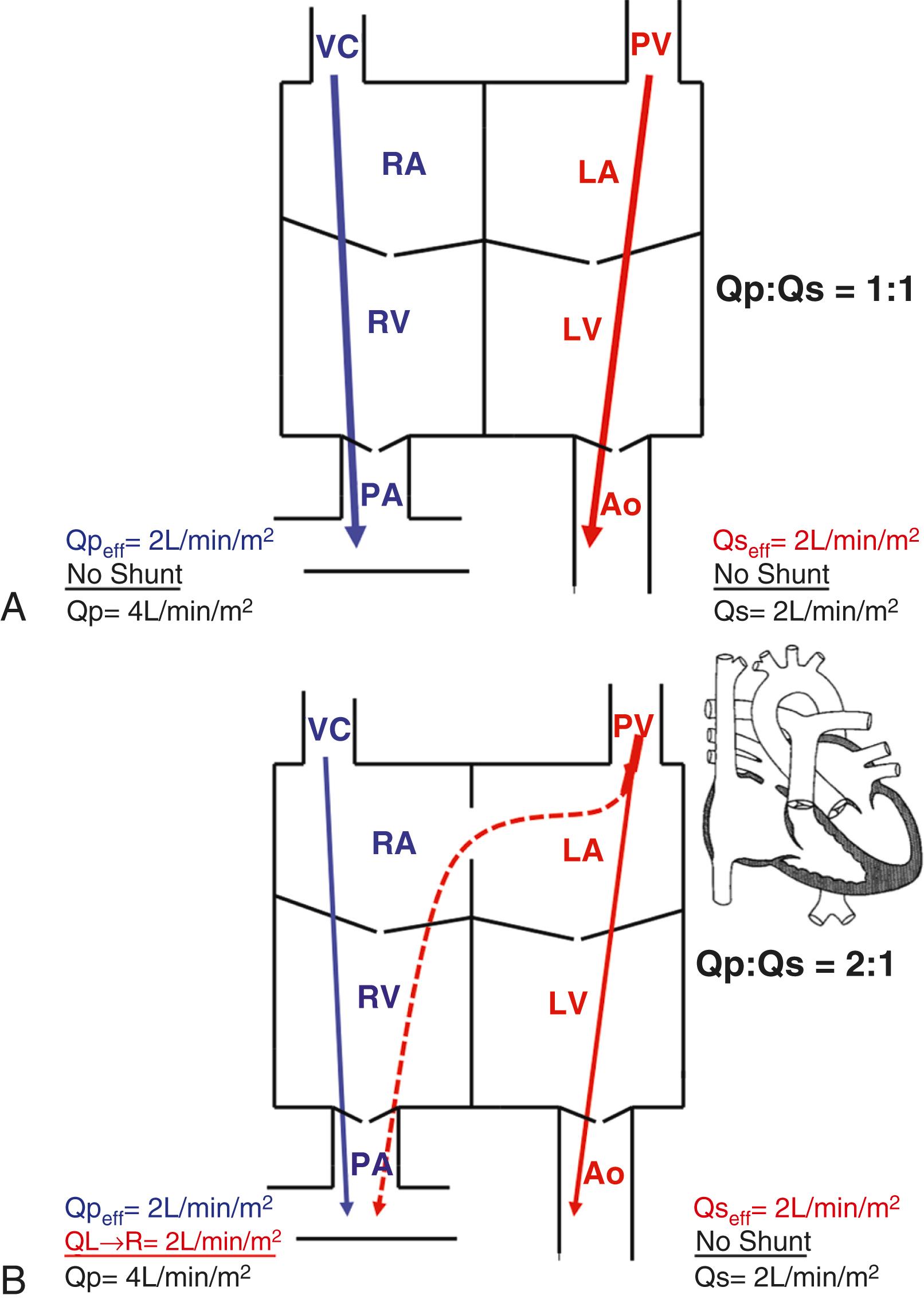
SaO 2 content is systemic arterial oxygen (O 2 ) content.
MVO 2 content is mixed venous O 2 content.
PaO 2 content is pulmonary arterial O 2 content.
PVO 2 content is pulmonary venous O 2 content.
Hb is hemoglobin concentration.
Blood O 2 content = [(Blood O 2 saturation) • (Hb • 1.34)] + PaO 2 • 0.003
If the blood is sampled while the patient is receiving an F i O 2 < 0.30, the dissolved O 2 portion of the content equation (PaO 2 • 0.003) can be ignored. If the Hb is constant across all samples then the (Hb • 1.34) term becomes a constant and cancels out of the equation. Blood O 2 saturation then replaces content in the equation:
In the presence of an intracardiac shunt, superior vena cava O 2 saturation is used in place of MVO 2 saturation.
In the absence of lung disease, pulmonary venous O 2 saturation is assumed to be 97%–100% with an F i O 2 < 0.30.
It is important to appreciate that alterations in the ratio of pulmonary vascular resistance to systemic vascular resistance (PVR:SVR) will have a greater effect on the distribution of blood flow for shunt lesions that are in close proximity to the great vessels (VSD, aortopulmonary shunt) than it will for lesions that are more remote (ASD). In addition, obstruction to flow downstream from the site of the defect influences shunt flow. For example, with a VSD left ventricular outflow tract obstruction (subaortic membrane or aortic stenosis) will increase L-R shunting regardless of the defect size, while right ventricular outflow tract (RVOT) obstruction (subpulmonic stenosis or pulmonary valve stenosis) will decrease L-R shunting regardless of the defect size, and if severe will promote R-L shunting (eg, tetralogy of Fallot [TOF]). A key consideration in management of patients with shunt lesions is manipulation of the SVR, the PVR, and the ratio between the two defined as PVR:SVR. The effect of alterations of SVR and PVR on the distribution of systemic and pulmonary blood flow and the physiologic variables that can be used to manipulate this distribution are summarized in Fig. 16.2 .
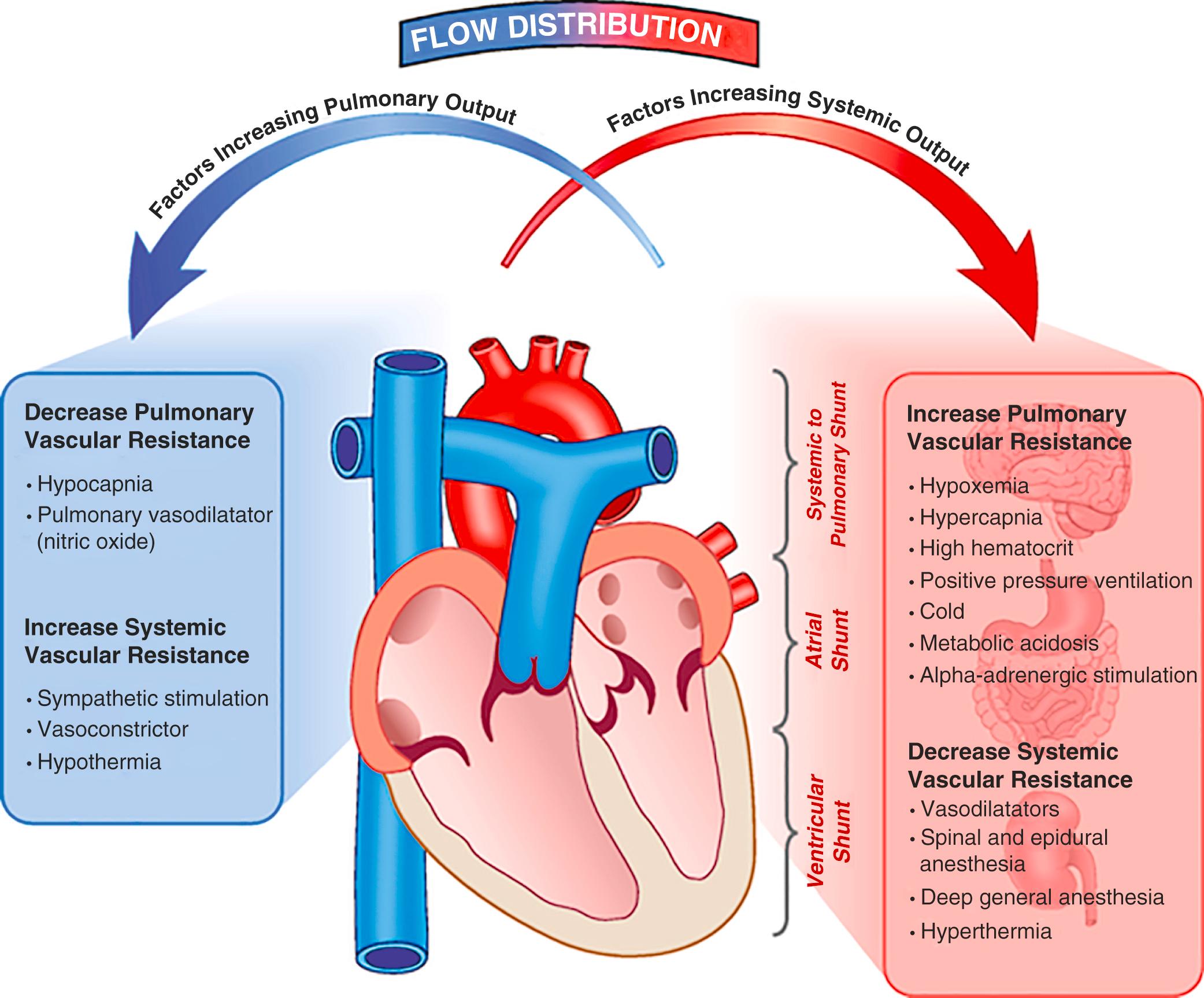
Adults with CHD may develop pulmonary hypertension primarily for two reasons. The most common reason is sequelae of long-standing large, nonrestrictive L-R shunt lesions. These lesions allow for delivery of increased flow to the pulmonary vascular bed. In the case of shunts at the ventricular or great artery level they also allow for transmission of systemic or near systemic pressures to the pulmonary bed. In both instances this leads to irreversible vascular changes and elevated PVR; the changes occur more rapidly in the presence of both increased flow and pressure. The vascular changes are characterized by angioproliferative vasculopathy in the pulmonary arterioles, leading to endothelial and smooth muscle proliferation and dysfunction, inflammation, and thrombosis. , The second cause is due to pulmonary venous hypertension. This may be due to pulmonary vein stenosis or elevated pulmonary venous atrial (normally the LA) pressure from obstructive lesions in the atrium, atrioventricular (AV) valve stenosis or regurgitation, or due to left heart disease (ventricular systolic and/or diastolic dysfunction).
Pulmonary hypertension is defined as mean pulmonary artery pressure (mPAP) ≥ 20 mm Hg as measured by right heart catheterization (RHC). Pulmonary arterial hypertension (PAH) or precapillary pulmonary hypertension is defined as an mPAP by RHC ≥ 20 mm Hg, pulmonary capillary wedge pressure (PCWP) ≤ 15 mm Hg, and pulmonary vascular resistance index (PVRI) greater than or equal to 3 Wood units/m 2 . Following cavopulmonary anastomosis (Fontan procedure) the definition of PAH is PVRI > 3 Wood units/m 2 or a transpulmonary gradient > 6 mm Hg even if the PVRI < 3 Wood units/m 2 . Pulmonary hypertension due to left heart disease (PH-LHD) is defined as an mPAP of > 20 mm Hg and PCWP > 15 mm Hg during RHC. PH-LHD can be classified into two main subtypes: isolated postcapillary PH (IpcPH) and combined post- and precapillary PH (CpcPH). RHC assists in defining the subtype of PH-LHD by defining the PVR, transpulmonary pressure gradient (TPG), and the diastolic pressure gradient (DPG). DPG is calculated by subtracting diastolic pulmonary artery pressure (dPAP) from PCWP; TPG is the difference between PCWP and mPAP. PH-LHD classifications are summarized in Table 16.7 .
| PH-LHD | IpcPH | CpcPH |
|---|---|---|
| mPAP (mm Hg) a | >20 | >20 |
| PCWP/LVEDP (mm Hg) | >15 | >15 |
| PVR (Wood unit) | ≤3 | >3 |
| TPG (mm Hg) | ≤12 | >12 |
| DPG (mm Hg) | <7 | ≥7 |
a The 6th World Symposium on Pulmonary Hypertesion used mPAP > 20 mm Hg to define PH-LHD
Left uncorrected the natural history of large, unrestrictive L-R shunt lesions (Q P :Q S > 1.5–2.0) is development of Eisenmenger syndrome (ES). This syndrome is defined as PAH with a nonrestrictive intracardiac or extracardiac communication and chronic cyanosis. It was originally defined by Paul Wood in 1958 as “pulmonary hypertension at or near systemic level with reversed or bidirectional shunt between the pulmonary and systemic circulation and PVR >10 Wood units).” Despite advances in management, there is significant mortality among contemporary adults with ES, and 25.3% of patients die over a follow-up period of 3.1 years. It is interesting that ES patients with pretricuspid valve lesions such as a large ASD, PAPVR, or coronary sinus (CS) defect have poorer outcomes than patients with posttricuspid valve lesions such as VSDs and patent ductus arteriosus (PDA). , It has been postulated that the development of ES and pressure loading of the right ventricle (RV) in patients with pretricuspid shunts occurs later in life, which does not allow time for adaptations that occur earlier in the presence of posttricuspid shunts. Closure of shunt lesions should not be performed in adults with a net R-L shunt and a PA systolic pressure greater than two-thirds SVR or PVR greater than two-thirds systemic. ,
The presence of ES presents some additional anesthesia challenges related to the end-organ effects of severe cyanosis (SaO 2 < 85%–90%). ES promotes secondary erythrocytosis (increased hemoglobin concentration and hematocrit) as an appropriate compensatory response to hypoxia and reduced blood oxygen concentration and tissue oxygen delivery. The risk of thromboembolic events and hyperviscosity symptoms is low in well-hydrated, iron-replete patients. Phlebotomy or plasma exchange to maintain a hematocrit level within an arbitrary predetermined level (hematocrit < 65%) is not indicated and may be associated with a higher risk of cerebrovascular events. Chronic cyanosis is also associated with an increased bleeding risk, likely due to decreased plasma volume and low platelet counts, and to gout related to the high uric acid levels associated with increased red cell mass.
Pulmonary hypertensive (PH) crises result from acute elevations in pulmonary vascular impedance that cause an increase in RV afterload and a worsening cycle of right heart dilation, reduced delivery of blood to the left ventricle causing reduced cardiac output, hypotension, and RV ischemia. The interconnected cascade of events that contribute to circulatory collapse in this setting are summarized in Fig. 16.3 . Treatment involves use of inhaled nitric oxide (NO), inotropic support of the RV, vasopressor support to maintain mean arterial blood pressure to resolve RV ischemia, and treatment of the underlying initiating cause of increased PVR ( Fig. 16.2 ). While the pulmonary vasodilator effects of milrinone may be useful in other settings where PVR is elevated, it has little utility in a PH crisis when systemic blood pressure is low and RV ischemia is present.
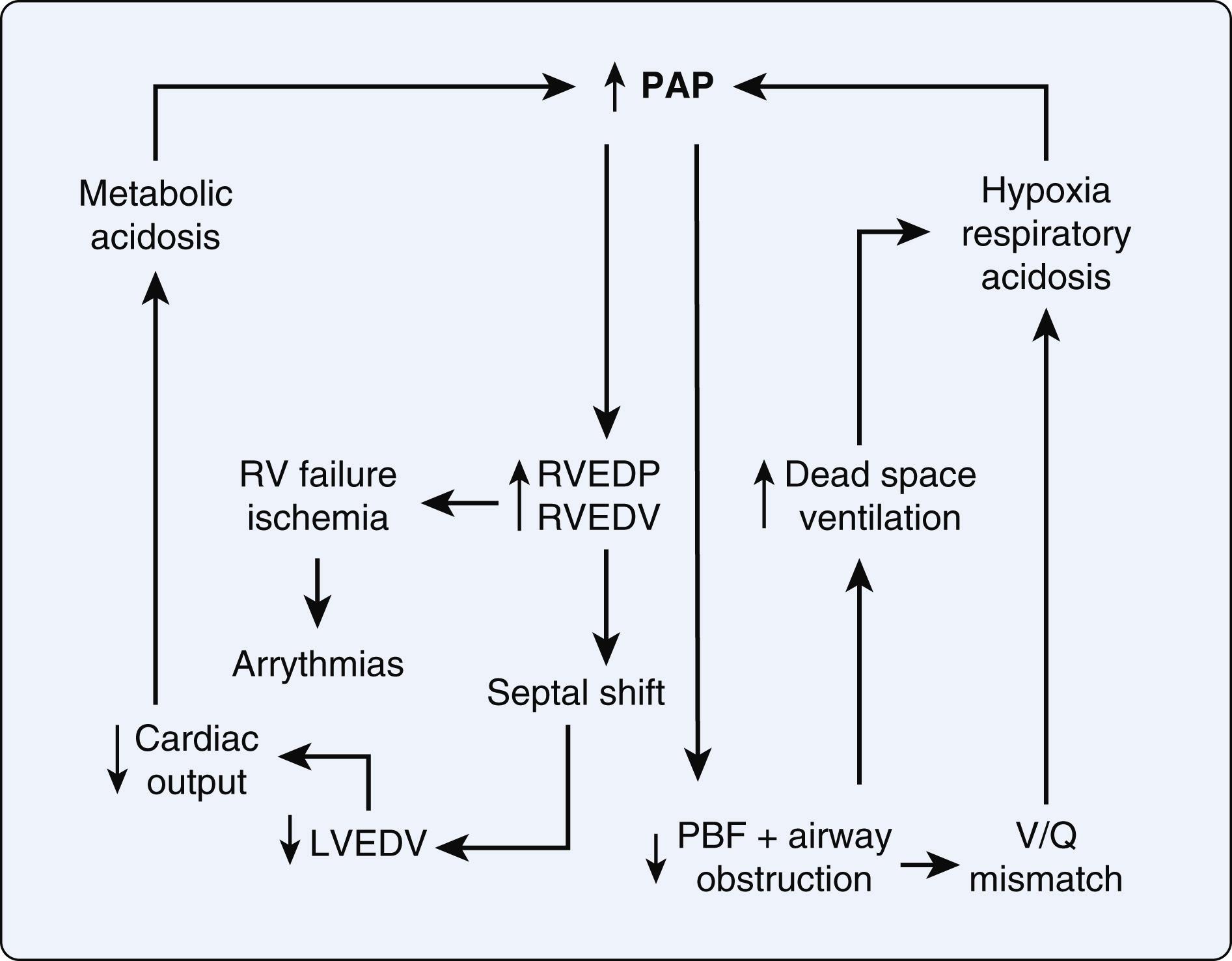
Fontan circulation is a series circulation used to palliate congenital cardiac lesions where there is only one ventricle with sufficient diastolic, systolic, and AV valve function to support systemic circulation. In some instances, there are two ventricles but only one is of sufficient size and/or function to support a series circulation in a biventricular circulation. The Fontan palliation requires that the systemic ventricle(s) be in unobstructed continuity with the aorta and in unobstructed continuity with the pulmonary venous blood. There must also be unobstructed delivery of systemic venous blood to the pulmonary circulation (total cavopulmonary continuity). There are a large variety of lesions that are palliated to a Fontan circulation. These are summarized in Table 16.8 . Fig. 16.4 summarizes the various pathways in which single-ventricle lesions, including hypoplastic left heart syndrome (HLHS) are palliated to a Fontan circulation.
| Lesion | Aortic Blood Flow From | Pulmonary Artery Blood Flow From |
|---|---|---|
| HLHS | PDA | RV |
| Severe neonate aortic stenosis a | PDA | RV |
| IAA a | LV (proximal), PDA (distal) | RV |
| PA/IVS | LV | PDA |
| Tetralogy of Fallot with pulmonary atresia a | LV | PDA, MAPCAs |
| Tricuspid atresia, NRGA, with pulmonary atresia (type 1A) | LV | PDA, MAPCAs |
| Tricuspid atresia, NRGA, with restrictive VSD and pulmonary stenosis (type 1B) | LV | LV through VSD to RV |
| Tricuspid atresia, with nonrestrictive VSD and no pulmonary stenosis (type 1C) | LV | LV through VSD to RV |
| Tricuspid atresia, D-TGA with nonrestrictive VSD and pulmonary atresia (type 2A) | LV through VSD to RV | PDA, MAPCAs |
| Tricuspid atresia, D-TGA with nonrestrictive VSD and pulmonary stenosis (type 2B) | LV through VSD to RV | LV |
| Tricuspid atresia, D-TGA, with nonrestrictive VSD and no pulmonary stenosis (type 2C) | LV through VSD to RV | LV |
| Tricuspid atresia, D-loop ventricles, L-TGA, subpulmonic stenosis (type 3A) | LV | LV through VSD to RV |
| Tricuspid atresia, L-loop ventricles, L-TGA, subaortic stenosis (type 3B) | LV through VSD to RV | LV |
| Truncus arteriosus a | LV and RV | Aorta |
| DILV, NRGA | LV | LV via BVF |
| DILV, L-loop ventricles, L-TGA, restrictive BVF | LV via BVF, PDA | LV |
a Amenable to complete two-ventricle repair; all other require staging to Fontan palliation.
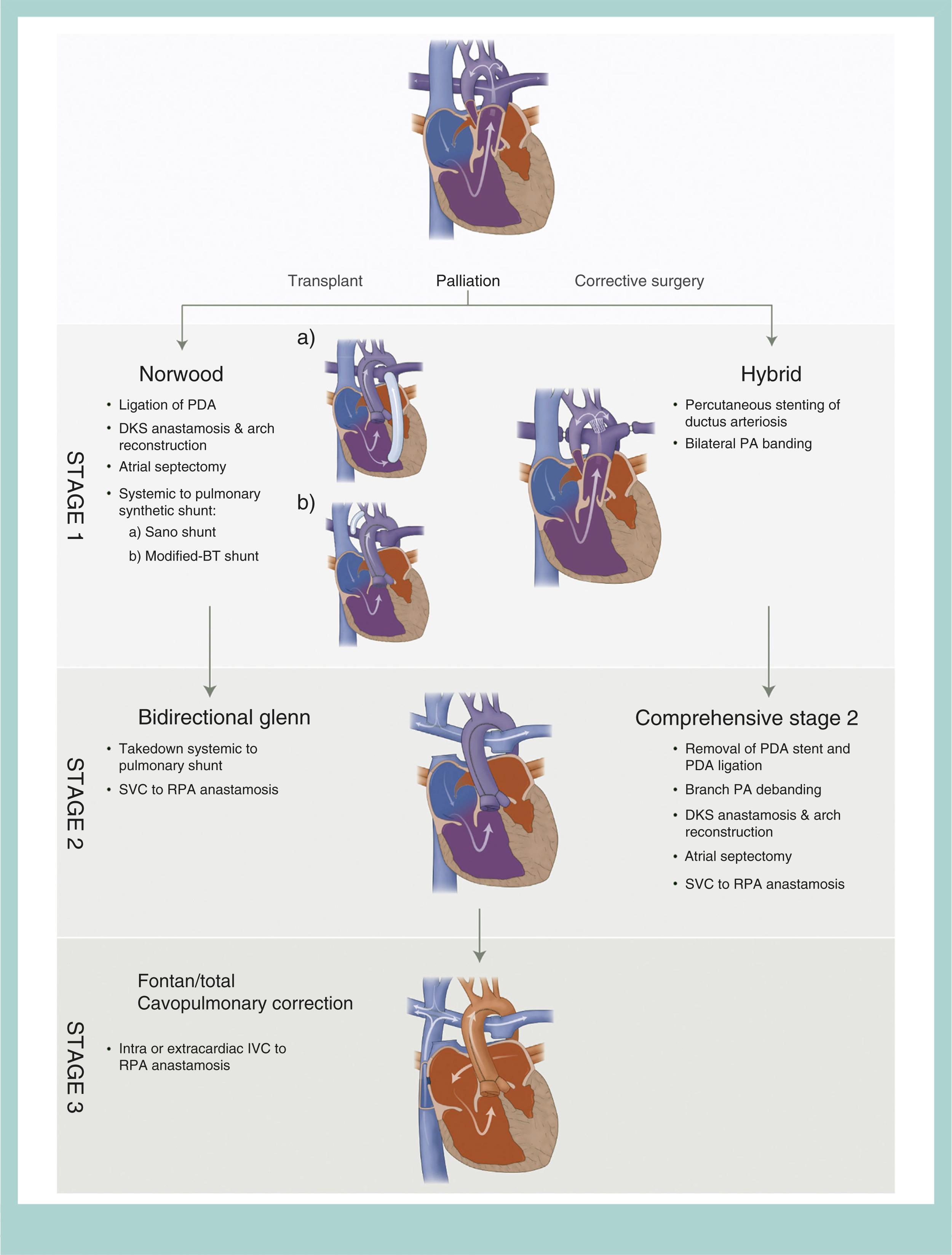
In the absence of any residual physiologic, intracardiac, or intrapulmonary R-L shunting these patients should have a normal SaO 2 . However, many Fontan patients have a 4-mm fenestration in the baffle of the cavopulmonary connection. This communication allows a small R-L shunt, which allows cardiac output to be maintained in the presence of a high transpulmonary gradient (such as increased PVR); in essence trading arterial oxygen saturation for cardiac output. The anatomic connections, blood flow, and chamber saturations present in a fenestrated Fontan circulation are shown in Fig. 16.5 .

It is often stated that pulmonary blood flow in the Fontan circulation is passive; in fact, it is gradient driven (systemic venous pressure > mPAP > pulmonary venous atrial pressure). The systemic ventricle generates the energy necessary to create the pressure gradient. The gradient is necessary to provide flow through the pulmonary capillary bed because the systemic vascular bed and pulmonary vascular bed are in continuity without an intervening atria and ventricle to provide a reservoir and pumping capacity ( Fig. 16.6 ). As a result, the single ventricle in a series Fontan circulation is faced with higher afterload and lower preload than the systemic ventricle in a two-ventricle series circulation. In addition, in order to maintain elevated systemic venous pressure a larger portion of the venous blood volume (70% of total blood volume) is stressed volume (volume that generates pressure) rather than unstressed volume (volume that does not generate pressure) due to venoconstriction.

Currently, the most commonly performed total cavopulmonary connections are the lateral tunnel (LT) and extracardiac (EC) Fontan. The LT procedure avoids incorporating any substantial volume of atrium in the cavopulmonary pathway, while the EC procedure does not incorporate any atrium. Historically, an atriopulmonary (AP) anastomosis was constructed to create total cavopulmonary continuity.Over time elevated systemic venous pressure leads to atrial dilatation in patients with an AP. The atrium often expands to a volume as large as 300 to 500 mL. This is a source of stasis and a nidus for atrial arrhythmias. The extracardiac procedure may offer additional protection from development of atrial arrhythmias due to a lack of suture lines within the atrium. These variations are shown in Fig. 16.7 .
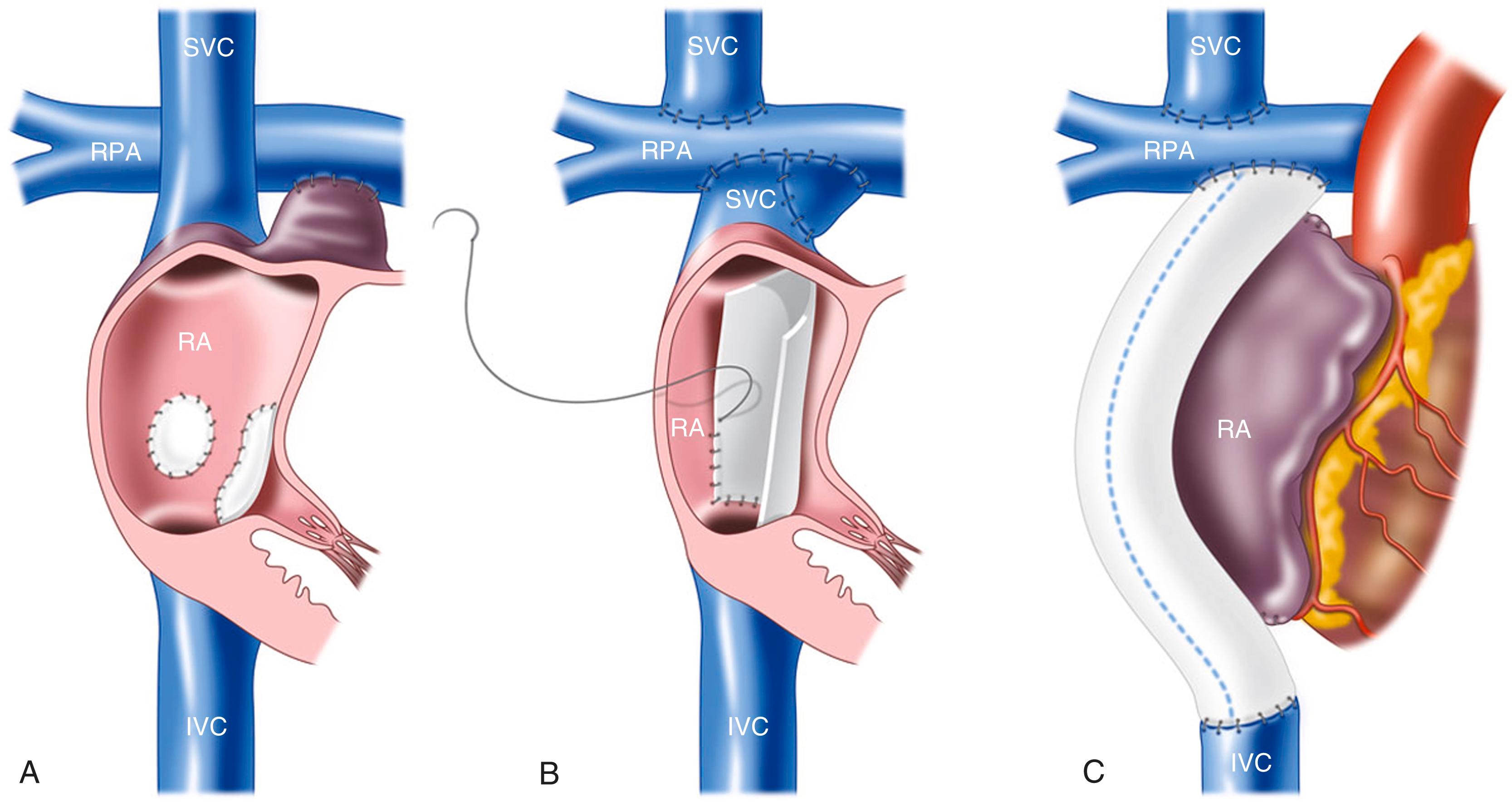
Anatomic aortopulmonary shunts maintain regulated pulmonary blood flow (PBF) and are created to palliate cyanotic CHDs in which PBF is deficient until definitive corrective repair is feasible. The most often encountered aortopulmonary shunts in the adult with CHD are shown in Fig. 16.8 . These include the classic Blalock-Taussig shunt (BTS, direct anastomosis of right subclavian artery to the right PA), the modified BTS (mBTS, interposition 3- to 4-mm polytetrafluoroethylene tube graft between a subclavian artery and PA), the Waterston shunt (ascending aorta to right PA), and the Potts shunt (descending aorta to left PA). These shunts increase the volume load on the systemic ventricle that may lead to ventricular dilation and dysfunction. ACHD patients palliated with these shunts are at high risk to have developed PH and ES.
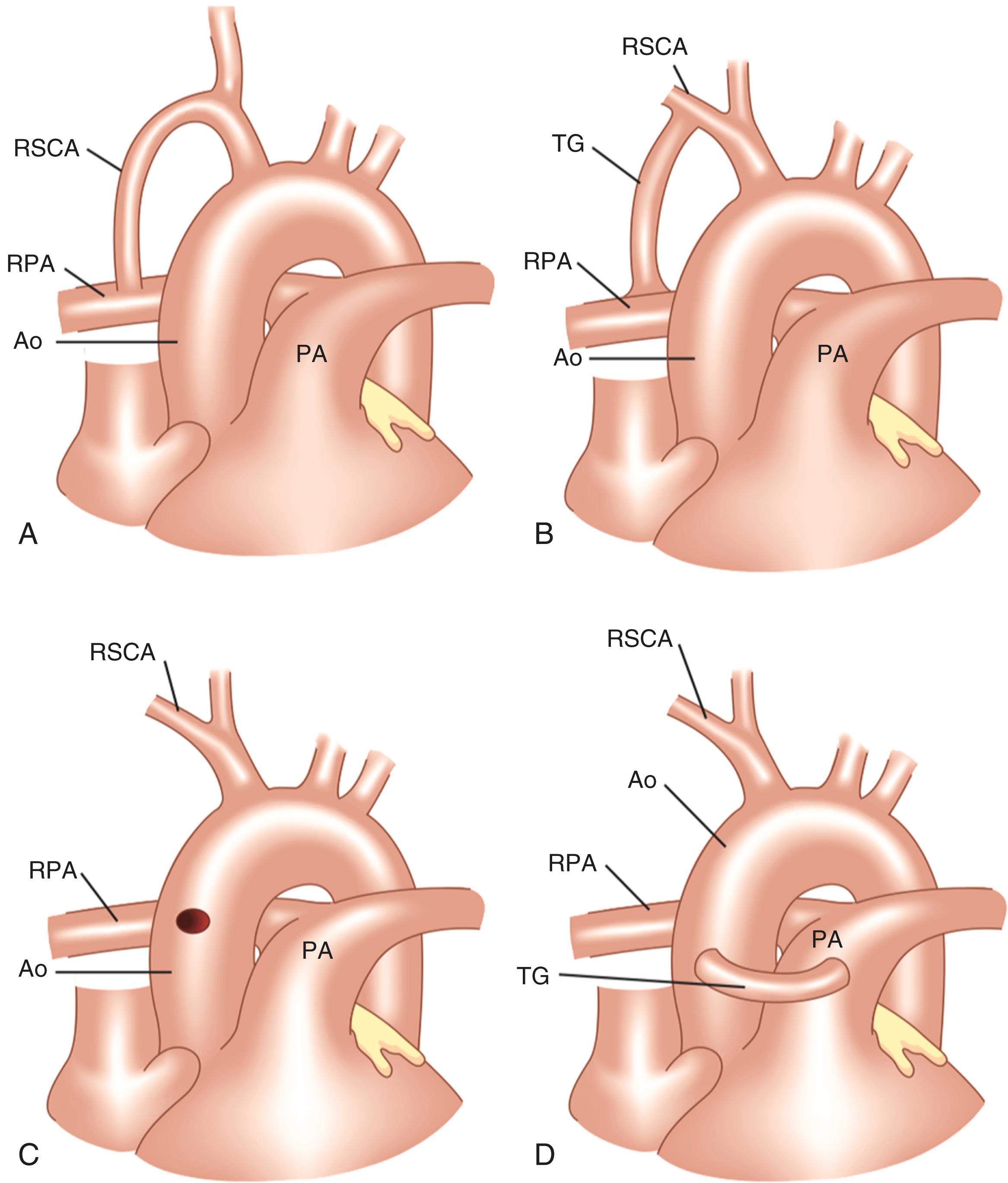
The limb ipsilateral to a classic BTS is perfused through collateral flow around the shoulder and may have palpable pulses even after the shunt. Blood pressure measurements are likely to be artifactually lower than systemic blood pressure and are best measured on another limb or confirmed to be the same as systemic blood pressure. Blood pressure discrepancies are also seen on the limb ipsilateral to an mBTS, though less pronounced; they may persist after the shunt is taken down because of focal stenosis at the arterial anastomosis site.
Become a Clinical Tree membership for Full access and enjoy Unlimited articles
If you are a member. Log in here